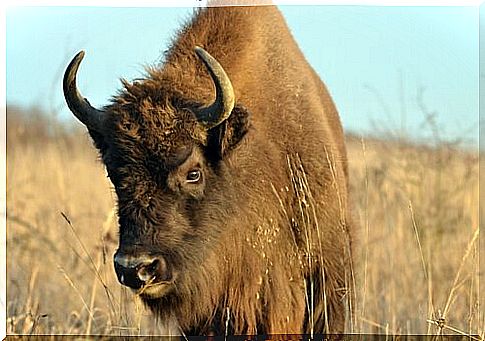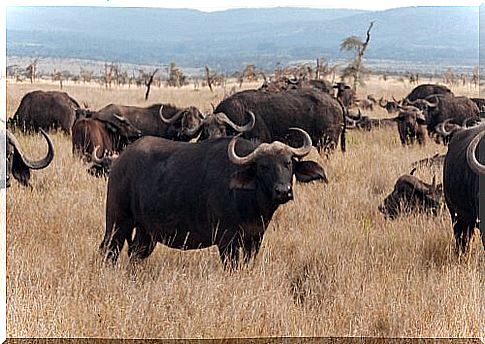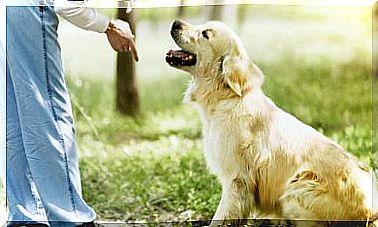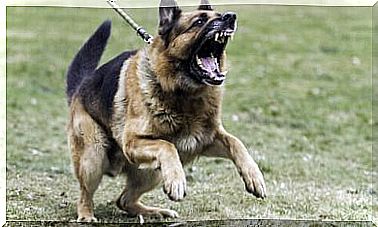Differences Between Bison, Wildebeest And Buffalo

While they may be confusing at first glance, there are actually many differences between bison, wildebeest, and buffalo. But what are the characteristics and peculiarities of these mighty animals? What do they have in common? How do they differ? Find out in this article what differentiates bison, wildebeest and buffalo.
At the origin of these three different names, there is a small but fundamental historical error. In fact, the first American settlers called the bison they found with the name of “buffalo”, and this created a lot of disorder. On the contrary, they are very different species also in relation to the habitat in which they live.
Bison, wildebeest and buffalo live in different areas
The American bison finds its natural habitat in North America. As for buffaloes, the two best known species of these animals reside mainly in Asia and Africa. Finally, the wildebeest predominates in Africa, especially in the Serengeti area.
We must also remember the European bison, which lives in some areas of Poland, integrated in small communities.
This animal was about to disappear and was able to resist extinction only thanks to the intervention of policies aimed at conserving this very ancient species. It is the same bovine that was hunted by primitive European tribes, often represented also in caves, as in Altamira.

Some differences between bison, wildebeest and buffalo
In fact, the family of origin of bison and buffalo is common : these are the so-called bovids , which contain over 100 different species of herbivorous mammals.
If you look at the photos of these animals, you will see that there are obvious differences between bison, wildebeest and buffalo. The American bison has a kind of hump, which protrudes behind its shoulders. In addition, his head is very large, almost disproportionate.
In the case of the buffalo, there is a kind of small wig on its head from which its powerful horns are born. They extend in the opposite direction and have a curvature towards the end.
These imposing antlers not only perform a deterrent function, but also serve the buffalo to remove the mud from the marshes in which it lives and throw it on its back, to wash and hydrate itself.
The wildebeest is the only one that has a mane like horses, has a narrower structure and is a very tall animal. Unlike the other two “cousins”, moreover, its horns have a more linear structure and almost form a perfect “L” on the outside.
Main differences between bison, wildebeest and buffalo
Physical aspect
The length of the fur is one of the most important differences. The bison is characterized by a coat with abundant wool, which grows more during the winter season. Its horns are short and extend to both sides and towards the back of the head.
In the case of buffaloes, their coat is shiny but short. The horns of some buffaloes grow and grow, until they weigh the same width as the animal.
As mentioned before, in addition to the simple mane, the wildebeest does not have any fur, for the simple fact that the climate of its habitat does not make it necessary. In some adult males, a beard that is even quite prominent can grow.
Habitat and location
As we have seen, the bison’s natural habitat is found throughout much of the United States, southern Canada and northern Mexico. You can observe communities of these specimens in flat areas, although they are also found in the mountains.
The buffalo lives in Asia and North Africa. Some small buffalo populations are found in Southern Europe, South America and even Australia.
Wildebeest are the herbivorous animals that thrive most successfully on the African continent and it is estimated that in the Serengeti National Park, Tanzania, more than 1 million of these even-toed animals migrate each year in search of new pastures.
Relations with the man
The bison has always been massively hunted by humans. In the 19th century, and following the North American expansion to the west, the bison was on the verge of extinction due to indiscriminate hunting.
The situation of the buffalo is very different. Buffalo have always been domesticated as a good source of dairy and also as a strong agricultural tool. It is rarely used as a source of meat, especially considering the fact that in some Asian countries it is considered a sacred animal.
The wildebeest is also hunted for its meat even if the incidence of hunting by man has only affected the species of southern Africa (black wildebeest or white-tailed wildebeest ).
The culture
The bison has often been the protagonist of films inspired by the American Far West. It was kind of a symbol of that era, of that kind of cinema and historical stage.
There are many protected areas and farms in the United States where bison farming is more of a tourist attraction than an economic resource.
In addition, the buffalo are sacred animals in Hindu religion and their consumption is prohibited. However, this taboo is not followed by all religious communities in Asia and Africa.
In a more playful aspect, in South Asia, several celebrations are held each year involving bullfights and buffalo races.
We know the wildebeest better
This animal belongs to the antelope family and is very different from the other two species we have told you about. Its large head has a square shape, and its horns are sharp and pointing upwards.

The wildebeest’s body is covered in a gray coat and its muzzle looks like it has a beard. The particular shape and length of the head, narrow and stretched forward, allows it to eat short grass.
As seen, the wildebeest habitat coincides with the heart of the African continent, especially in the center, east and south. They usually live in lowlands, savannas, and flat forests with lots of grass, as well as near agricultural areas and pastures.
They are very social animals and move in groups to escape from possible predators: wild dogs, cheetahs, leopards, lions and crocodiles.








